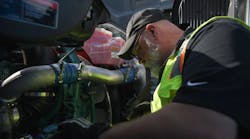“The importance of managing warranty, especially parts warranty, is one area where fleets and service providers are in agreement,” says Michael Riemer, vice president, product and channel marketing, Decisiv (www.decisiv.com), a leader in Service Relationship Management (SRM) and provider of the first IoT PaaS solution for commercial asset service management.
“Fleets are always interested in maximizing warranty coverage reimbursement,” he says. “Service providers not only want to streamline that process for their customers, but are equally interested in ensuring payments by manufacturers as quickly as possible.”
There are several challenges surrounding warranty claims recovery and reimbursements for both parties. Many of these issues can be addressed by an effective approach to frictionless data sharing during service events.
Coverage
First on that list is to know what's covered and what isn't before a repair begins, says Decisiv’s Riemer. Fleets and service providers need to quickly identify whether an item is under warranty. In many cases, however, much of the information can be difficult to find.
“Even if you’re tracking warranty in an internal Fleet Maintenance System (FMS),” he adds, “you face challenges because those systems are not always up-to-date when it comes to warranty information, especially for repairs done by outside service providers, as well as for having ready access to warranty provisions and coverages.”
Service work done at external providers may not be adequately captured in FMS applications for as long as 30 to 60 days after the work is performed, notes Riemer. This means that repeat repairs and repeat part replacements may be occurring with no real-time visibility.
“Warranty management is especially challenging for fleets with multiple locations,” he explains. “For example, one location might complete a warranty repair, but if that information isn’t easily shared another location may replace the component a second time without realizing it, and the fleet manager won’t be alerted to investigate what may be an underlying issue.”
Point of Service
The more information that fleets and service providers have at the point of service, the more efficient the warranty process, says Riemer of Decisiv. “By using an advanced information platform that ensures up-to-date information – no matter where the repair is performed, all service supply chain participants have access to warranty information when and where it is needed,” Riemer says. “With enhanced collaboration and data sharing capabilities, fleets no longer have to worry about whether something as simple as a missed phone call will hold up a covered repair or prevent them from capturing warranty reimbursements.
“Moreover, when policy coverage questions come up during a repair, having access to required information and being able to quickly and efficiently communicate with the warranty provider – including OEM field representatives to expedite a decision – is critical,” he adds. “Fleets don't want to pay for a repair that should be covered, and service providers don't want to do the work if they are not going to get paid.”
Reporting Standards
VMRS (Vehicle Maintenance Reporting Standards) coding also enhances warranty tracking, notes Decisiv’s Riemer. Available via a license from the American Trucking Associations (www.trucking.org) – the largest national trade association for the trucking industry – VMRS is the standard, universal language for service event and asset maintenance.
When it is adopted by a service supply chain, it helps to automate notifications of coverage based on the system, assembly or part (as described in VMRS code keys 31, 32 and 33) that is being worked on.
“As VMRS coding of warranties (OEM and replacement parts) becomes a more common practice and is fully integrated with advanced software applications, the entire service supply chain will become more efficient while also reducing costs,” he says.
Service Relationship Management (SRM)
The Decisiv Service Relationship Management (SRM) platform for commercial vehicles and heavy equipment streamlines access to critical, in-context information at the point of service including warranty coverages, as well as recalls, service bulletins, due-maintenance operations and other pending work.
The cloud-based software enables real-time communication and collaboration, electronic estimate creation and approval, and VMRS coding of the event and labor operations, explains Riemer.
“The Decisiv SRM platform is the only truly open API-based system that allows inter-operability across any OEM or service network for warranty coverage, parts catalogues, build information, remote and shop tool diagnostics and most leading business systems at fleets and service providers,” he says.
The company is “revolutionizing service event management in North America by helping reduce triage time more than 70 percent and lowering downtime as much as 50 percent,” he says. “Leading trucking OEMs (e.g., Mack, Volvo, Peterbilt, Kenworth and Hino); dealers/service providers (WheelTime and Vehicare); and leasing and maintenance providers (NationaLease and Ryder) are already leveraging the Decisiv platform at more than 3,000 service locations and on more than two million assets.
“When vehicles are in for repair, lost and unproductive time is spent trying to understand current coverage, and that is costly for everyone,” concludes Riemer. “Leveraging SRM technology across the service supply chain ensures a high level of fleet reimbursement, service provider payments and lower OEM costs.”




